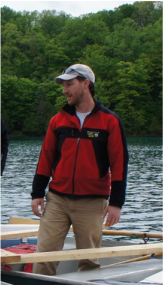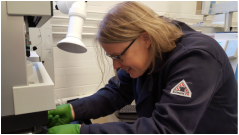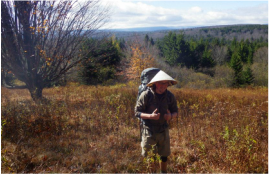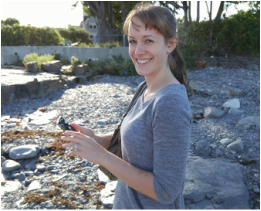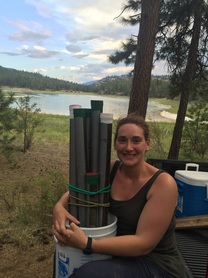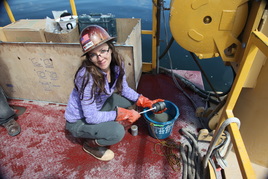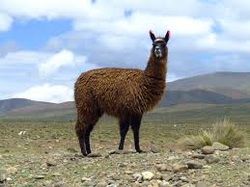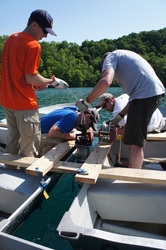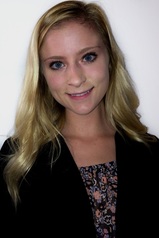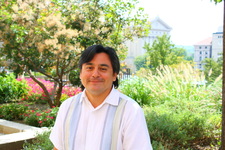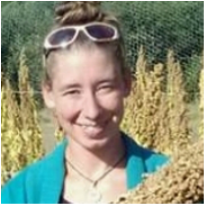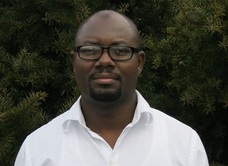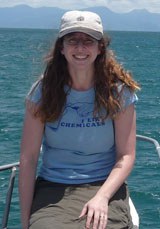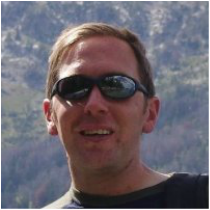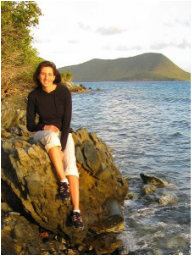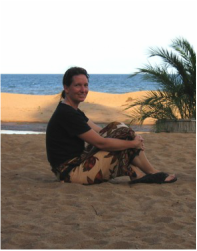People
|
Josef Werne
Associate Professor Dr. Josef Werne received his PhD in Geological Sciences at Northwestern University in 2000 with an emphasis in Biogeochemistry. He was a Postdoctoral Research Scientist at the Royal Netherlands Institute for Sea Research from 2000-2002 and on the faculty of the Large Lakes Observatory and Department of Chemistry & Biochemistry (Assistant/Associate Professor) at the University of Minnesota Duluth before joining the Department of Geology & Environmental Science at the University of Pittsburgh in 2012. Dr. Werne spent a year in Perth, Australia, as a Gledden Visiting Senior Fellow at the Institute for Advanced Studies of the University of Western Australia, as well as a visiting scientist in the Western Australia Organic and Isotope Geochemistry Centre at Curtin University (2009-2010). |
|
Elisabeth Svensson
Lab Manager/Research Specialist Elisabeth manages the instrument and wet chemistry labs of the Werne Research group. She earned a bachelors degree in Chemistry at the University of Gothenburg, Sweden, and a master of science at the University of Connecticut in Marine Chemistry. She is currently finishing her PhD in Organic Biogeochemistry at the NIOZ Royal Netherlands Institute for Sea Research. |
Graduate Students
|
Troy Ferland
Graduate Student, Ph.D. Troy received his undergraduate degree in chemistry from the University of Pittsburgh in the spring of 2015. His current project is analyzing lake cores from Lake Magadi, Kenya, in collaboration with the Hominin Sites and Paleolakes Drilling Project, with the goal of determining whether Lake Magadi is a good candidate for further study using biomarkers to provide insight into the environment of East Africa during the evolution of early hominids. He is broadly interested in studying Earth’s biogeochemical cycles, how they have changed over geologic time, and the implications of those changes on the evolution of life. |
|
Damara Strong
Graduate Student, Ph.D. Damara's research project is focused on calibrating and applying molecular isotopic proxies to paleoclimate reconstruction from lacustrine sediments in Mesoamerica, especially Lago Peten Itza, Guatemala. Her primary interest is in understanding variability in hydroclimate using leaf wax hydrogen isotopes. She earned a bachelors degree from Northern Arizona University in Environmental Science with a minor in Chemistry, where she carried out research in lake systems from Arizona to Alaska. |
|
Dervla Kumar
Graduate Student, Ph.D. Dervla's research is focused on understanding the sources and environmental controls on branched glycerol dialkyl glycerol tetraether lipids (brGDGTs). These important biomarker compounds are derived from as-yet unknown bacteria, and have been found ubiquitously in soils and sediments. They have the potential to serve as continental paleotemperature proxies, if we can deconvolve the myriad environmental factors that affect their distribution in lake systems. Her research will combine analyses of intact polar lipids, carbon isotopes, and DNA. Dervla earned a bachelors degree from the State University of New York at Binghamton with a major in Geological Sciences. Before coming to Pitt, she worked at Schlumberger as a measurements while drilling field specialist. |
|
Molly O'Beirne
Graduate Student, Ph.D. Molly's PhD research is focused on understanding the biogeochemistry of organic sulfur formation using compound-specific stable isotope analysis. Her research ranges from laboratory sulfurization experiments, to sampling of sulfidic lake waters and sediments from sites such as Mahoney Lake, British Columbia (pictures at left) and Fayetteville Green Lake, NY, to analysis of organic sulfur compounds preserved in the Jurassic Kimmeridge Clay Formation, in the UK. She earned a bachelors degree in Biochemistry from Bemidji State University, and a masters in Water Resources Science working at the Large Lakes Observatory of the University of Minnesota Duluth. In her spare time, she dabbles in carbon and nitrogen isotopes. |
|
Arielle Woods
Graduate Student, Ph.D. Arielle's research looks at late Quaternary hydroclimate in tropical South America. She uses lacustrine geochemical and molecular biomarker proxies to reconstruct the spatiotemporal patterns and mechanisms of monsoon variability in the Andes over decadal to orbital timescales. She is developing a site-specific calibration for hydrogen isotope values in leaf waxes and algal lipids for Lake Junin (Peru) which she will apply to the biomarker assemblage in long cores recovered during the Lake Junin Deep Drilling Project in 2015. She earned a bachelor's from University of Wisconsin-Madison (2010) in Conservation Biology and African Studies and spent semesters in Ecuador and Kenya. Post undergrad she took classes in climate at University of Chicago, followed by a stint with the Park Service in Alaska. She first experienced geology fieldwork with the Quaternary Research Group at Tulane University, collecting sediment cores to study the evolution of the Mississippi Delta, and has been hooked on paleoclimate ever since. |
Undergraduate Students
|
Elizabeth Holmes
Undergraduate student Elizabeth is a senior studying Anthropology, Geology, Chemistry, and Spanish. Her project involves looking at specific organic molecules derived from human and camelid (llama) feces (fecal sterols - we call them "poopenols") preserved in lake sediments as indicators of population and herding activity in the Titicaca Basin of Peru. |
|
Tyler Myers
Undergraduate Student Tyler (in orange shirt at left) is a senior Geology major. He has helped the research group with field work in New York and British Columbia, and is working on his own research looking at the leaf wax hydrogen isotope record of precipitation from sediments in Laguna de Juanacatlan, Mexico. |
|
Christina Puhnaty
Undergraduate Student Christina Puhnaty is a senior Chemistry major with a concentration in Biological and Geological Sciences, minoring in German. She plans to attend graduate school for Environmental Chemistry. Her goal is to obtain a career that applies analytical chemistry techniques to the interpretation of environmental data. |
Gone but not forgotten:
Previous graduate students & postdocs - and where they are now
|
Sergio Contreras
Postdoctoral Research Associate Current Position: Professor, Faculty of Sciences, Catholic University of the Santísima Concepción I am interested in the biogeochemical role of the biosphere and hydrosphere in the Earth System focusing in the natural variability and how climate change could affect its dynamic. I take a multi-directional approach to studying changes or perturbations of the Earth system focused in marine and freshwater ecosystems by partaking in a wide range of studies, such as organic biogeochemistry, nitrogen, carbon and water cycle dynamics, and paleoclimatology. By combining a wide range of techniques and studies I hope to gain a deeper understanding of not just the individual indicators of global change, but also how the feedbacks and interactions between systems can affect the signals we interpret. |
|
Brittany Kruger
PhD, 2014 Current Position: Staff Scientist, Desert Research Institute, University of Nevada Reno Sources, Cycling, and Fate of Organic Matter in Large Lakes: Insights from Stable Isotope and Radiocarbon Analysis in Lakes Malawi and Superior. PhD Thesis, Water Resources Science, University of Minnesota |
|
Prosper Zigah
PhD, 2011 Current Position: Postdoctoral Scholar, Department of Marine Chemistry & Geochemistry, Woods Hole Oceanographic Institution Sources, biogeochemical cycling, and fate of organic matter in Lake Superior: An investigation using natural abundance radiocarbon and stable isotopes. PhD Thesis, Water Resources Science, University of Minnesota |
|
Melissa Berke
PhD, 2011 Current Position: Assistant Professor, Dept. of Civil & Environmental Engineering & Earth Sciences, University of Notre Dame Molecular and isotopic records of climate variability and vegetation response for tropical East Africa during the latest Pleistocene and Holocene. PhD Thesis, Geology and Geophysics, University of Minnesota |
|
Martijn Woltering
PhD, 2011 Current Position: Research Scientist, Earth Science & Resource Engineering, CSIRO, Australia Thaumarchaeota distribution in the water column of Lake Superior and Malawi; implications for the TEX86 lacustrine temperature proxy. PhD Thesis, Water Resources Science, University of Minnesota |
|
Isla Castañeda
PhD, 2007 Current Position: Assistant Professor, Dept. of Geological Sciences, UMass Amherst Paleoenvironmental variability in the southeast African tropics since the Last Glacial Maximum: Molecular and isotopic records from Lake Malawi. PhD Thesis, Geology and Geophysics, University of Minnesota |
Thesis titles of all former graduate students
PhD:
Kruger, Brittany Ruth. 2014. Sources, Cycling, and Fate of Organic Matter in Large Lakes: Insights from Stable Isotope and Radiocarbon Analysis in Lakes Malawi and Superior. PhD Thesis, Water Resources Science, University of Minnesota
Zigah, Prosper Kojo. 2011. Sources, biogeochemical cycling, and fate of organic matter in Lake Superior: An investigation using natural abundance radiocarbon and stable isotopes. PhD Thesis, Water Resources Science, University of Minnesota
Berke, Melissa Ann. 2011. Molecular and isotopic records of climate variability and vegetation response for tropical East Africa during the latest Pleistocene and Holocene. PhD Thesis, Geology and Geophysics, University of Minnesota
Woltering, Martijn Leonard. 2011. Thaumarchaeota distribution in the water column of Lake Superior and Malawi; implications for the TEX86 lacustrine temperature proxy. PhD Thesis, Water Resources Science, University of Minnesota
Castañeda, Isla Sarita. 2007. Paleoenvironmental variability in the southeast African tropics since the Last Glacial Maximum: Molecular and isotopic records from Lake Malawi. PhD Thesis, Geology and Geophysics, University of Minnesota
Powers, Lindsay. 2005. Calibration and application of a new paleotemperature tool in lacustrine systems: TEX86 for continental paleoclimate reconstruction. PhD Thesis, Water Resources Science, University of Minnesota
MS:
O’Beirne, Molly D. 2013. A 10,000 year sedimentary organic geochemical record of Lake Superior. MS Thesis, Water Resources Science, University of Minnesota
Cantarero, Sebastian. 2013. Multiproxy paleoclimatic record from geochemical analyses of Lake Chalco sediments, a closed basin lake in central Mexico. MS Thesis, Geological Sciences, University of Minnesota
Pierce, Megan Leigh. 2012. A 40,000 year geochemical record from Lake Chalco, Mexico. MS Thesis, Geological Sciences, University of Minnesota
Du, Miao. 2012. A multiproxy record of Asian monsoon variations during the last 15,000 years from Peiku Co, Tibetan Plateau. MS Thesis, Geological Sciences, University of Minnesota
Zhang, Cong. 2011. Organic Matter Sulfurization during Early Diagenesis in Florida Bay. MS Thesis, Chemistry & Biochemistry, University of Minnesota
Abbott, April. 2011. Pleistocene Temperature Variability in East Africa: A 1.2 Million Year TEX86 Record from Lake Malawi. MS Thesis, Geological Sciences, University of Minnesota
Strzok, Ladislaus. 2011. Changing Nutrient and Productivity Regimes in Lake Superior: Causes and time course. MS Thesis, Chemistry & Biochemistry, University of Minnesota Duluth
Bernhardt, Beth. 2010. Validation of the MBT-CBT Paleotemperature Proxy: Effects of Environmental and Seasonal Variability in Soils and Lacustrine Sediments. MS Thesis, Water Resources Science, University of Minnesota
Woltering, Martijn. 2008. Late Pleistocene temperature history of southeast Africa: A TEX86 temperature record from Lake Malawi. MS Thesis, Water Resources Science, University of Minnesota
Donahue, Michael. 2006. Inferred Sulfate Reduction Rate and Associated Fractionation from the Cariaco Basin. MS Thesis, Water Resources Science, University of Minnesota
Xiao, Zilan. 2005. The biomarker record of Elk Lake, Minnesota – implications for Holocene vegetation response to climate change. MS Thesis, Chemistry, University of Minnesota
Pearson, Keely. 2005. An assessment of environmental changes during the Holocene as recorded in the bulk geochemical and molecular signals of lake superior sediments. MS Thesis, Water Resources Science, University of Minnesota
